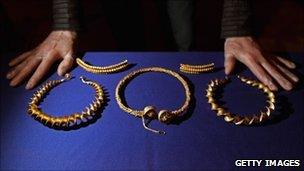Treasure hunter set for Iron Age gold find reward
- Published

The neck ornaments were found in a field near Stirling
A man who unearthed a hoard of Iron Age gold the first time he used his new metal detector is set to receive almost £500,000 as a reward for the discovery.
Amateur treasure hunter David Booth found the four neck ornaments - or torcs - in a field near Stirling in September 2009.
The gold, worth about £1m, dated from between the 1st and 3rd Century BC.
National Museums Scotland will receive the treasure trove, provided they pay £462,000 to Mr Booth.
The chief game warden at Blair Drummond Safari Park, near Stirling, said he was "over the moon" after hearing about the reward.
"I'm going to pay off the credit cards and loans and buy a new house for the family," he said.
"The landowner will get his share as well."
Mr Booth said he found the torcs in the first hole he dug after trying out his new metal detector last year.
He added: "I can't wait to take my kids along to the museum to show them - and the rest of Scotland can see them too."
Under Scots law, the Crown can claim any archaeological objects found in Scotland.
Finders have no ownership rights and must report any objects to the Treasure Trove Unit.
'Amazing' find
The Scottish Archaeological Finds Allocation Panel (Safap) has recommended the items be handed to the National Museums Scotland - provided they make the ex gratia award to Mr Booth.
The decision was announced by the the Queen's and Lord Treasurer's Remembrancer Catherine Dyer, who as the Crown's representative in Scotland can claim buried archaeological or historic items.
Ms Dyer said: "This is a very significant find, the most important hoard of Iron Age gold ever found in Scotland.
"That these stunning artefacts have been unearthed in such excellent condition after being buried for 2,000 years is simply amazing."
The four torcs were just six inches beneath the surface when Mr Booth discovered them with his metal detector.
Professor Ian Ralston, chairman of Safap, said: "The panel is grateful to the finder for reporting these highly important finds in good time and for the further assistance from the finder during fieldwork by the National Museum at the site of the discovery.
"This has allowed much greater understanding of the archaeological context of these four exceptional items."
Dr Gordon Rintoul, National Museums Scotland director, said he would be looking at a number of ways to raise the money for the reward.
"These magnificent Iron Age gold torcs are of national and international importance and we are delighted that National Museums Scotland will now have the opportunity to acquire them for preservation and display," he said.
"In the context of the current difficult economic climate, we will be exploring a range of sources of funding to secure what is a substantial sum to ensure these items remain available for future generations within the national collections."
Since the discovery, Mr Booth has also found an 800-year-old medieval seal near Stirling.
He said he was still waiting to hear how much the find was worth.
- Published8 July 2010